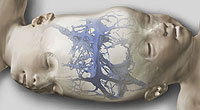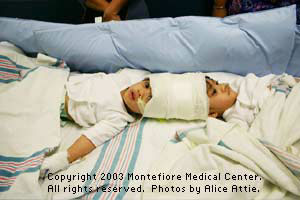| Egyptian Conjoined
Twins Separated and Updates of Other Conjoined Twins |
| Egyptian Conjoined
Twins Separated and Updates of Other Conjoined Twins |
|
By Ellen Kuwana Neuroscience for Kids Staff Writer October 17, 2003 Updated: February 25, 2004
October 12, 2003: Egyptian Conjoined Twins Separated in Dallas, TexasTwo-year-olds Mohamed and Ahmed Ibrahim, formerly joined at the crown of their heads, were separated in a 34-hour operation at Children's Medical Center Dallas on October 12, 2003. The boys did not share a brain, but the surgery was complicated by the large number of blood vessels that the twins shared, including the sagittal sinus, the main vessel that drains blood away from the brain. After surgery, the boys were in stable condition, recovering in a medicine-induced coma (the doctors wanted to keep the boys in a coma for about a week so that they stayed still long enough to allow swelling in the brain to go down). At this time, it is unknown if the boys will have any brain damage. Upon regaining consciousness, the boys face a future of physical therapy and more reconstructive surgeries.
After the Surgery: Rehabilitation and RecoverySince October, the boys have been working with physical, speech and occupational therapists about two times a day to learn to walk and talk. For the first 28 months of their lives, they were joined, and as such could not explore their world easily. Thus, their language, motor (balance, movement, muscle coordination) and social skills are delayed compared to children their age. |
  Medical Modeling
LLC, 2002 Medical Modeling
LLC, 2002
|
October 2003Mohamed, the more active, outgoing brother, sat upright for short periods of time with the assistance of a therapist. His progress was the faster of the two, but doctors emphasize that it is normal for the two boys to progress at different rates.
November 2003Mohamed sat for 30 minutes with assistance. As his neck muscles got stronger, he was soon able to hold his head upright. Ahmed, the quieter brother, was strong enough to hold a crawling (on hands and knees) position briefly. Soon he, too, was able to sit. Both boys were fitted for protective headgear that will keep their skulls safe while they continue therapy and gain mobility.
December 2003With advances in movement and speech, the boys were soon able to graduate to sessions in the therapy gym, where they could swing and play on balance balls. Mohammed could stand with very little support, and spoke words in both English and Arabic. Ahmed sat and held his head upright with no help. Ankle braces will be fitted to support his legs so that he can learn to walk. Ahmed spoke his first word (in Arabic). Mohamed can count and says, "Ready, set, go!"January 2004The new year was marked by continued improvement by both boys. The hospital staff nicknamed Mohamed "Superman" and Ahmed "The Philosopher." The nursing staff learned some basic words in Egyptian so that they could communicate better with the boys. Their mother helped set a schedule that will resemble the boys' life when they return to Egypt.
February 2004The boys can now play together, and often sing songs such as "Row, Row, Row Your Boat" along with their therapists. The twins' story is featured on Oprah, who interviews Dr. Kenneth Salyer, a surgeon with the non-profit World Craniofacial Foundation. He says that the twins will need at least two more surgeries; the next reconstructive surgery to further repair their skulls is planned for April, when both boys are stronger. Dr. Salyer notes that the boys' recovery has proceeded so smoothly because of their young age. |
 Ibrahim family with First Lady of Texas Anita Perry. Courtesy of Medical City Dallas Hospital. The numbers alone tell a story. The surgery required more than 50 personnel, including:
|
|
References:
|
October 12, 2003: Greek Conjoined Twins Separated in Rome, ItalyThese four-month-old girls, whose identity has been kept a secret, were separated after a 12-hour operation. They were joined at the temple of their heads, near the eye socket. One concern is whether each girl will have normal eyesight. This surgery was less complicated than others because these twins did not share any organs, just bone. Still, more than 30 medical personnel were involved in the surgery. Their recovery proceeded as expected. References:
|
October 20, 2003: Surgeons Insert Tissue Expanders and Perform a Craniotomy in the First Surgery on Philippine Conjoined TwinsCarl and Clarence Aguirre are conjoined twins who are joined at the tops of their heads. They do not share a brain, but do share some veins, including a major one, the sagittal sinus. When the twins arrived in New York on September 10, 2003, from the Philippines, they were 60% underweight. Their first task was to gain weight. They gained a total of five pounds, and at this healthier weight had their first surgery on October 20, 2003. One part of this five-and-a-half-hour surgery consisted of inserting tissue expanders under the boys' scalps. The expanders are essentially pouches, which are gradually filled with saline solution. This stretches the skin, creating enough skin for the surgeons to close the wounds after the separation surgery. The other part of the surgery was a craniotomy. The surgeons cut a small part of the skull away in order to view the brain and assess how interconnected the blood vessels were. As pediatric surgeon James T. Goodrich, director of Pediatric Neurosurgery at The Children's Hospital at Montefiore, explained it, the surgeons tied off some common vessels to "close off the bridging veins, which will encourage them each to further develop their own venous networks."
December 11, 2003: Philippine Conjoined Twins Undergo Second Surgery of a Planned Series in New YorkThe 20-month-old boys have recovered nicely from the second surgery, despite an earlier setback after the first surgery when an infection made it necessary for two tissue expanders to be removed. Another tissue expander was placed under Carl's scalp in the second, five-and-a-half-hour surgery. Unfortunately, it also had to be removed, due to a minor infection a week after the second surgery. In this second surgery, surgeons separated more of the blood vessels shared by the twins. Dr. Goodrich reported that the surgeries were progressing as planned. "We are right on target. We are about 50-60% of the way through now." This second surgery marked the point where more than half of the shared blood vessels are tied off. All vessels must be tied off before the boys can be separated. The most difficult surgery is still to come, said Dr. Goodrich. The upcoming surgery is when the surgeons will tackle the complex task of separating a large group of intertwined veins toward the back (posterior) of the brain, including the major one: an abornomally shaped sagittal sinus vein. Only one twin will receive the sagittal sinus to use; the other twin will have to rely on other, smaller vessels to drain blood away from the brain back to the heart. The boys continue to show no signs of neurological damage. They have gained three more pounds since the October surgery, and continue with their therapy sessions. Carl, the larger of the two, keeps busy practicing his first few words. Clarence has resumed sticking his tongue out at the doctors. It is estimated that one to two surgeries are needed to fully separate the twins.
February 23, 2004This third surgery, which involved 16 medical personnel and lasted more than five hours, was described as "tedious, treacherous and tenacious" by Dr. Goodrich. It was the riskiest surgery so far, the one in which surgeons tackled the large shared vessel called the sagittal sinus, an important vein that leads blood from the brain back to the heart. Many minor vessels were separated, and surgeons declared the twins 90% of the way towards separation. With each operation, surgeons cut a different "window" of skull, and work inside that window to separate the intertwined blood vessels. Then the skull is reassembled with titanium plates and screws. This creates the circle of skull which will be ultimately separated. At this time, only about three inches remain to still be cut, then the boys will be fully separated.Clarence, who had the better circulatory system to begin with, received the sagittal sinus. It is hoped that Carl will reroute bloodflow through other vessels. The boys are now almost 2 years old, and have begun to try to crawl on hands and knees. One more surgery is planned before the twins can be separated. There is still one more major blood vessel toward the back of the skull that needs to be tied off. The Advantages of Performing Several SurgeriesAfter reviewing 84 of the 90 separation operations that have been performed worldwide, the surgeons decided that several smaller surgeries would be safer than one marathon operation. In the next two to three months, it is likely that three more surgeries will be performed to divide shared blood vessels before the major separation surgery. It is hoped that these smaller surgeries will gradually encourage separate blood flow to and from the brain of each boy. Other advantages of doing the operations in stages include:
Medical staff at Blythedale Children's (Valhalla, NY) and Montefiore Medical Center (Bronx, NY) are donating their time and skills. The cost of the surgeries is estimated at two million dollars. References:
| |
| The Aguirre Twins | |
 |
 |
| Did You Know? |
|
| GO TO: | Neuroscience In The News | Explore the Nervous System | Table of Contents |
![[email]](./gif/menue.gif) Send E-mail |
 Get Newsletter |
 Search Pages |